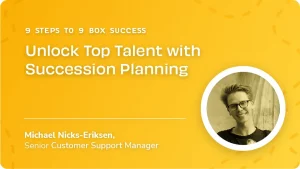10 Employee Retention Strategies That Actually Work
Posted by Trakstar • October 7, 2022 • 11 min read
Employee retention strategies seem to be what all HR leaders, C-Suites, and anyone who manages employees are talking about. Finding good employees is difficult, but keeping them is even more challenging. Everyone is talking about retention strategies because the cost of employee churn is too much for some companies to bear – and they are pausing hiring and working with a relative skeleton crew.
The problem? This results in even more churn. It’s a cyclical process, and HR leaders are often caught in the middle of the circle, trying to take care of everything at once.
Trakstar’s platform is purpose-built to help HR leaders and give them the tools they need to take on the fight. Our software includes applicant tracking, performance management, learning management, and data analytics tools that automate talent management processes so that HR leaders can focus on crucial tasks related to attracting, retaining, and engaging their best employees. To learn more about Trakstar, you can schedule a demo today.
10 Employee Retention Strategies For A Modern Workforce
What retention strategies really work? It’s hard to identify what will help your efforts and what is just adding to your long list of tasks. We’ve worked with companies of all sizes and scopes, and we’ve been able to identify some strategies that reap the most rewards.
Talent Retention Strategy #1: Improve Training
Implementing an on-demand training program can help to improve employee retention for a few reasons. The primary reason is that your employees falling somewhere in the middle of your workforce are given the tools they need to be great within your company. No one wants to be a “middle performer.” Everyone wants to be a high-achieving employee.
We know that not everyone can be, but we also know that there’s a chance to educate, upskill, and motivate employees to be better. By improving training, you are showing your employees that you are willing to invest in them instead of hiring someone who is a better performer.
Particularly in industries like construction and manufacturing, there can be resentment when new employees come in with a higher salary, a higher ranking, and more say in what happens. This resentment builds toxicity and leads to churn. When you promote from within, you give employees a “one of us” feeling that not only makes for a better culture, but builds better leaders and loyalty.
How to do it:
- Invest time in creating better training courses.
- Use a learning management system.
- Prioritize training for all employees.
Recruitment and Retention Strategy #2: Onboarding Matters
Your onboarding program matters! Studies have shown that organizations with good onboarding programs will have better retention rates. Onboarding may not seem like a retention strategy, but it is. Onboarding should take more than a few days. Be sure you have routine check-ins with your new employees for at least the first 90 days of employment, then fall into a regular employee check-in process.
Sometimes, there will be a piece of your onboarding program that you want to change. When you change it, be sure to ask for feedback and reflect with employees in different departments, with varying personality types, and from diverse backgrounds. Onboarding is so difficult to design because it needs to meet so many kinds of people, but it isn’t impossible to do.
How to do it:
- Build a better onboarding curriculum.
- Check the ROI of your programs.
- Constantly update your materials to reflect your workforce.
New Employee Retention Strategy #3: Build a Mentoring Program
Mentoring programs have somewhat fallen out of fashion over the last few years. However, they still hold a lot of power. Create a mentoring program to keep your employees engaged and not lose some of the historical wisdom that can come with employees retiring and leaving your company. Preserving historical knowledge about how things are done is always a good idea.
Start by identifying employees who can teach younger, greener employees about what they do. Have them mentor your younger employees for a specific period of time and see who helps grow better talent.
Then, you can preserve their knowledge by taking videos, recording audio, or creating presentations that you can use for years to come. You’ll be able to use those recordings as a resource during onboarding, upskilling, and strategy.
How to do it:
- Use a 9-box grid to identify top performers.
- Equip mentors with the skills the need.
- Assign all new employees to a mentor.
Retention and Motivation Strategy #4: Talent Development
Identify future leaders and create career pathways with Individual Development Plans while developing the skills of your employees with emerging talent. If you find an exemplary employee willing to be coached and taught new things, you can put them into your talent development program.
What does a talent development program look like? It includes things like upskilling, reskilling, mentoring, performance management, SMART goals, succession planning, and so much more. Nearly all of your employees should be involved in some kind of development program to help motivate and retain them. Some may be in a more vigorous program than others, but the goal is to keep them all motivated.
How to do it:
- Build a talent development program using talent management software.
- Identify what areas of talent development would most help your organization.
- Set goals to know how you’re doing.
Employee Retention Strategy #5: Engaged Employees Stay
You will be able to track the flight risk of top performers by monitoring their level of engagement with surveys. When you run an engagement survey, do they take it? What do your results look like if you require them to take it?
Engagement surveys can run anonymously or as a manager check-in tool that shows who answers. Employees are more likely to answer these survey questions honestly than to answer in-person questions with a manager or HR leader.
If you do run engagement surveys, be sure to follow up on them. If you’re asking for advice or areas to improve upon so that your retention stays high, be sure you’re doing some of the things that are suggested to you.
How to do it:
- Run engagement surveys to create transparency.
- Follow up on the surveys.
- Pay close attention to the number of employees who answer your rate.
Staff Retention Strategy #6: Eliminate Toxicity
No one wants to work in a toxic environment. It’s stressful for even the best employees and can encroach everywhere. A single toxic employee can spread their toxicity quickly, especially to new employees who are still learning what your culture is like.
Toxicity comes in many forms. Sometimes it is employees who don’t get along with each other, and other times, it is a high-achieving employee who looks down on other people. It can also be historically great employees who are now showing signs of burnout. Toxicity can come in remote environments as easily as it does in in-person environments. Reduce Zoom fatigue, keep meetings to a minimum, ensure everyone knows what is expected of them, and use engagement tools and 360-reviews to find out what’s really going on in your workforce.
How to do it:
- Ensure leaders know how to manage toxicity on your teams.
- Open up 360-reviews to identify toxic employees.
- Use PIPs to help interpersonal skills as well as performance skills.
Retention Strategy For Businesses #7: Know What’s Working
Knowing when something is working is one of the biggest battles you’ll have as a leader. It’s easy to see when something isn’t giving you the returns you wanted, but it’s harder to identify the things moving in the right direction. You’ll have to think about how you measure success.
If you’re using a performance review system, you might be able to see an increase in good reviews. If you’re using a learning management system, maybe you’ll start to see more engagement there. Perhaps you’ll see the results in a higher number of sales or in fewer no-call, no shows.
One way to measure what’s working and what isn’t is by using Trakstar Insights. This dashboard, available within all of our products, can help HR leaders take a pulse of their HR initiatives and understand what’s working out and what isn’t. This allows you to make the right decisions and changes to reduce churn and keep your employees happy and motivated.
How to do it:
- Find your starting point, then measure from there.
- Make micro changes to what you’re doing to see what makes the biggest impact.
Effective Employee Retention Strategy #8: Make Changes When You Must
If you have something that isn’t working, change it. Consistency matters (more on that in a bit), but if something isn’t working and hasn’t worked for a while, you need to change. This could be putting toxic employees on a performance improvement plan, giving burnout employees the time to rest, showing your appreciation for your employees, or starting a new initiative.
How to do it:
- Stay consistent.
- Be declarative in the changes you make.
- Treat all of your employees the same.
Employee Retention Strategy #9: Show Them What Good Looks Like
Sometimes your employees don’t know what you want from them. It’s up to you to show them what you want to see. All leaders must be models of what they want to see in their employees. Not only does this help them understand what is expected of them, but it also helps create a culture of excellence. Set expectations and keep your company culture aligned with them.
Modeling is a potent tool for leadership, and you should use it to your advantage. If you aren’t sure what good looks like at your company, then it’s a sign you need to work with your fellow leaders to create a handbook, set expectations, and develop culture.
How to do it:
- Model good behavior.
- Call out those who are doing what they need to do.
- Work on developing what good looks like if you don’t know.
Retention Technique to Try #10: Hire For Culture
Are you hiring for culture fit? It’s an important piece of the retention strategy puzzle that most people don’t think about. Why? Hiring and retaining employees don’t always seem to go hand-in-hand, but they do. When you hire someone who isn’t a cultural fit, there are two outcomes you need to consider:
- New employees will quickly realize they don’t “fit in” and leave your company.
- The new employee will change the culture and more seasoned employees could leave.
Neither of these options benefits you. It’s better to find new hires that fit in with your culture (if you have a good culture). You can do this by forming a hiring team, holding multiple interviews, and talking to your teams before building your job descriptions.
How to do it:
- Develop hiring teams to help you find the best fit.
- Ask questions about culture and beliefs.
- Use an applicant tracking system to keep track of information.
Effective Employee Retention Strategies Require Consistency
One thing to understand is that employee retention strategies require consistency in your efforts. You can’t try something for a few weeks and then move on to another strategy. This doesn’t create the type of culture that someone wants to stay for – instead, it can create confusion that leads to even more churn.
There are going to be some retention efforts that don’t work for your company, but you need to give them enough time to play out. When you make changes, you need to show your employees that you are serious about making things better for them. If they don’t trust your consistency, they will always wonder when things are going to get bad again.
Tired of Strategies for Employee Retention That Don’t Work?
Retention strategies that don’t work can be heartbreaking. It makes you question yourself and your purpose, which never feels good. When you partner with Trakstar, you’re not alone in your retention efforts. We know that attracting, retaining, and engaging talent is more complicated than ever, and you probably have more competition than you’re used to – but that doesn’t mean you should give up on retention efforts and anticipate a culture of churn and constant onboarding.
That doesn’t benefit anyone.
Effective HR software to help increase retention rates is a game-changer for all HR leaders, whether you have a small organization or thousands of employees. If you are ready to get started with a purpose-built talent development platform that incorporates an applicant tracking system, learning management system, performance management tools, and collects data, Trakstar is the only way to go. Click here to schedule a demo with a member of our team.
Don't Miss Out on More Great HR Articles!
Subscribe to get the latest, greatest HR and Talent Development content straight to your inbox.



